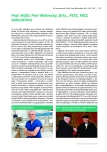The role of learning curve on the results of aortic valve implantation for severe aortic stenosis
Authors:
Petr Kala 1; Petr Němec 2,3; Petr Malík 2; Jiří Ondrášek 2; Martin Třetina 2; Petr Pokorný 2; Jiří Jarkovský 4; Milan Bláha 4
Authors‘ workplace:
Interní kardiologická klinika LF MU a FN Brno, pracoviště Bohunice, přednosta prof. MUDr. Jindřich Špinar, CSc., FESC
1; Centrum kardiovaskulární a transplantační chirurgie Brno, ředitel doc. MUDr. Petr Němec, CSc.
2; Mezinárodní centrum klinického výzkumu FN u sv. Anny – ICRC Brno, ředitel Gorazd B. Stonkin, M. D., MSc., Ph. D.
3; Institut biostatistiky a analýz LF MU Brno, ředitel doc. RNDr. Ladislav Dušek Ph. D.
4
Published in:
Vnitř Lék 2014; 60(4): 316-321
Category:
60th Birthday - prof. MUDr. Petr Widimský, DrSc., FESC, FACC
Overview
Introduction:
Patients with serious aortic stenoses treated by conservative therapy have significantly worse life expectancy. Besides the surgical aortic valve replacement (AVR) as the gold standard of therapy, the transcatheter aortic valve implantation (TAVI) is indicated in patients at very high risk or who are contraindicated to AVR. The role of learning-curve in TAVI has to be established.
Aim:
Assessment of the results of consecutive TAVI procedures based on the experience of the team. Methods: 58 high-risk consecutive patients with the average age of 82.2 years were divided into 3 groups based on the TAVI order (≤ 20., 21.–40., 41.–58.). After the Edwards SAPIEN implantation via transfemoral or transapical approaches, all patients were followed for minimum 30 days. Data from the national registry (Czech TAVI Registry) were used for the retrospective analysis. Comparison of the groups was done by using the Kruskal-Wallis test, Mann-Whitney U test and χ2 test.
Results:
Significantly shorter procedural time (p < 0.001), hospitalization (p = 0.033) and a lower amount of contrast medium (p < 0.001) was observed during the time. There was no difference in the rate of clinical complications at 30 days.
Conclusions:
Increasing experience of the TAVI implantation team is associated with significantly shorter procedural time, hospitalization and a lower amount of contrast medium. Overall very good clinical results during 30 days were not affected by the team experience.
Key words:
aortic stenosis – aortic valve implantation – TAVI – learning curve
Sources
1. Cribier A, Eltchaninoff H, Bash A et al. Percutaneous transcatheter implantation of an aortic valve prosthesis for calcific aortic stenosis: first human case description. Circulation 2002; 106(24): 3006–3008.
2. Vahanian A, Alfieri OR, Al-Attar N et al. European Association of Cardio-Thoracic Surgery; European Society of Cardiology; European Association of Percutaneous Cardiovascular Interventions. Transcatheter valve implantation for patients with aortic stenosis: a position statement from the European Association of Cardio-Thoracic Surgery (EACTS) and the European Society of Cardiology (ESC), in collaboration with the European Association of Percutaneous Cardiovascular Interventions (EAPCI). Eur J Cardiothorac Surg 2008; 34(1): 1–8.
3. Zelizko M, Maly M, Janek B et al. Transkatetrova implantace aortální chlopne CoreValve Interv. Akut Kardiol 2010; 19: (Suppl B): 9–13.
4. Nemec P, Ondrasek J, Malik P et al. Comparison of the surgical and trans-catheter aortic valve replacement in high-risk patients. Cor et Vasa 2012(2); 54: e62-e67.
5. Kala P, Tretina M, Poloczek M et al. Quality of life after transcatheter aortic valve implantation and surgical replacement in high-risk elderly patients. Biomed Pap Med Fac Univ Palacky Olomouc Czech Repub 2013; 157(1): 75–80.
6. Kala P, Blaha M. Czech TAVI Registry – rationale and design. Cor et Vasa 2012; 54(3): e143-e150.
7. Leon MB, Smith CR, Mack M et al. Transcatheter aortic-valve implantation for aortic stenosis in patients who cannot undergo surgery. N Engl J Med 2010; 363(17): 1597–1607.
8. Smith CR, Leon MB, Mack MJ et al. Transcatheter versus surgical aortic-valve replacement in high-risk patients. N Engl J Med 2011; 364(23): 2187–2198.
9. Miller DC, Blackstone EH, Mack MJ et al. Transcatheter (TAVR) versus surgical (AVR) aortic valve replacement: occurrence, hazard, risk factors, and consequences of neurologic events in the PARTNER trial. J Thorac Cardiovasc Surg 2012; 143(4): 832–843.
10. Leon MB, Piazza N, Nikolsky E et al. Standardized endpoint definitions for transcatheter aortic valve implantation clinical trials: a consensus report from the Valve Academic Research Consortium. Eur Heart J 2011; 32(2): 205–217.
11. Kappetein AP, Head SJ, Genereux P et al. Updated standardized endpoint definitions for transcatheter aortic valve implantation: the Valve Academic Research Consortium-2 consensus document. Eur Heart J 2012; 33(19): 2403–2418.
12. Gilard M, Eltchaninoff H, Iung B et al. Registry of transcatheter aortic-valve implantation in high-risk patients. N Engl J Med 2012; 366(18): 1705–1715.
13. Di Mario C, Eltchaninoff H, Moat N et al. The 2011–2012 pilot European Sentinel Registry of Transcatheter Aortic Valve Implantation: in-hospital results in 4,571 patients. EuroIntervention 2013; 8(12): 1362–1371.
14. Gurvitch R, Tay EL, Wijesinghe N et al. Transcatheter Aortic Valve Implantation: Lessons From the Learning Curve of the First 270 High-Risk Patients. Catheter Cardiovasc Interv 2011; 78(7): 977–984.
15. D´Ancona G, Pasic M, Unbehaun A et al. Transapical aortic valve implantation: learning curve with reduced operating time and radiation exposure. Ann Thorac Surg 2014; 97(1): 43–47.
Labels
Diabetology Endocrinology Internal medicineArticle was published in
Internal Medicine

2014 Issue 4
Most read in this issue
- Liver in heart failure
- Right ventricle in severe pulmonary hypertension in congenital heart defects – different and specific.
- Operation of Ebstein anomaly in adulthood – our experience
- Mitral stenosis
